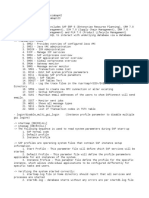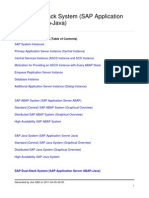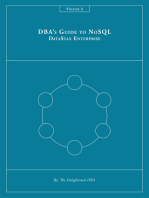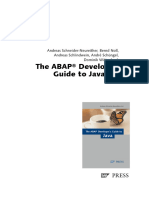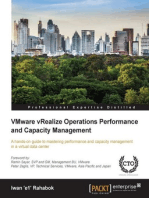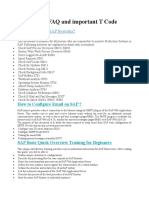Abap Vs Java Stack in Sap
Uploaded by
aniruddha_2012Abap Vs Java Stack in Sap
Uploaded by
aniruddha_2012How are JAVA, ABAP and Dual stack architecture differentiated in SAP?
Can anyone explain all these 3
architectures in details?
Answer:
In short, ABAP stack is what SAP had developed in house, in other words the native offering. ABAP stack
is the foundation of SAP Business Suite and is also the foundation of the new S/4 HANA suite.
It is a kind of "virtual machine" if you'd like to call it - providing a compiled language (ABAP)
environment on various different Hardware platforms and realize 100% compatibility. Majority of the
traditional SAP inter lecture property are actually built within the ABAP stack.
In comparison Java stack was adopted when SAP acquired Top Tier portal solutions. It was not the first
but the most serious and successful SAP entering Internet/web domain. As its name indicated, it uses
JVM and the programming language in this stack is ... JAVA.
Various "web-facing" SAP product leveraged JAVA stack extensively, most prominent of course is the
SAP Enterprise Portal. But also SAP XI, PI, and PO serious solutions. There were SAP HR ESS, MSS, BW
Java, features that used to use Java stack too (but are moving into ABAP).
There were a period where "webb-ize" everything drove the product direction to dual-stack Which
means one SAP system has two stacks: JAVA and ABAP sharing one identity. However as web is
becoming ubiquitous, the dual-stack operational cost seems stayed relatively high due to the fact that it
requires interaction of two pretty different product, and mentality.
So what SAP now recommending is split the dual stack - for example you can still have BW and BI-JAVA,
but they will be split into two systems and managed separately. The only dual stack system we still
recommend is Solution Manager which is used to manage all your SAP systems, so understandably, you
need this system to be both ABAP and JAVA.
On a larger scale, SAP is also consolidating its features, and reduce the need for "both ABAP and JAVA".
Many things like CRM ICC, HR ESS are nolonger require to be running in a separate (JAVA) stack. This
made operating SAP system much less costly.
You might also like
- Dual-Stack Split Procedure of Software Provisioning Manager 1.0No ratings yetDual-Stack Split Procedure of Software Provisioning Manager 1.016 pages
- Rails 4 For Startups Using Mobile And Single Page ApplicationsFrom EverandRails 4 For Startups Using Mobile And Single Page ApplicationsNo ratings yet
- SAP HANA Interview Questions You'll Most Likely Be AskedFrom EverandSAP HANA Interview Questions You'll Most Likely Be AskedNo ratings yet
- JAVA: Java Programming for beginners teaching you basic to advanced JAVA programming skills!From EverandJAVA: Java Programming for beginners teaching you basic to advanced JAVA programming skills!No ratings yet
- SAP Dual-Stack System (SAP Application Server ABAP+Java)No ratings yetSAP Dual-Stack System (SAP Application Server ABAP+Java)4 pages
- Kafka Up and Running for Network DevOps: Set Your Network Data in MotionFrom EverandKafka Up and Running for Network DevOps: Set Your Network Data in MotionNo ratings yet
- SAP on Azure Implementation Guide: Move your business data to the cloudFrom EverandSAP on Azure Implementation Guide: Move your business data to the cloudNo ratings yet
- Step by Step: Fault-tolerant, Scalable, Secure AWS Web StackFrom EverandStep by Step: Fault-tolerant, Scalable, Secure AWS Web StackNo ratings yet
- Student Book: CMAS Costa Rica Team Unit 1 SAP SystemsNo ratings yetStudent Book: CMAS Costa Rica Team Unit 1 SAP Systems8 pages
- NW 202 - Platform For Developing ABAP and Java Applications: Ulrich Klingels/Wolf Hengevoss Sap AgNo ratings yetNW 202 - Platform For Developing ABAP and Java Applications: Ulrich Klingels/Wolf Hengevoss Sap Ag19 pages
- IDES 6.0 EHP 7 Dual Stack Installation: 2 RepliesNo ratings yetIDES 6.0 EHP 7 Dual Stack Installation: 2 Replies2 pages
- System Provisioning SWPM 10 SP22 Java DualStack Trex 70No ratings yetSystem Provisioning SWPM 10 SP22 Java DualStack Trex 707 pages
- Code with Java 21: A practical approach for building robust and efficient applications (English Edition)From EverandCode with Java 21: A practical approach for building robust and efficient applications (English Edition)No ratings yet
- VMware vRealize Operations Performance and Capacity ManagementFrom EverandVMware vRealize Operations Performance and Capacity ManagementNo ratings yet
- Java Functional Programming Made Simple: A Practical Guide with ExamplesFrom EverandJava Functional Programming Made Simple: A Practical Guide with ExamplesNo ratings yet
- Four Programming Languages Creating a Complete Website Scraper ApplicationFrom EverandFour Programming Languages Creating a Complete Website Scraper ApplicationNo ratings yet
- Java Persistence with NoSQL: Revolutionize your Java apps with NoSQL integration (English Edition)From EverandJava Persistence with NoSQL: Revolutionize your Java apps with NoSQL integration (English Edition)No ratings yet
- Javascript For Abap Programmers: Chapter 1 - IntroductionNo ratings yetJavascript For Abap Programmers: Chapter 1 - Introduction12 pages
- Learn SQL with MySQL: Retrieve and Manipulate Data Using SQL Commands with EaseFrom EverandLearn SQL with MySQL: Retrieve and Manipulate Data Using SQL Commands with EaseNo ratings yet
- Java 9.0 to 17.0 Cookbook: A Roadmap with Instructions for the Effective Implementation of Features, Codes, and Programs (English Edition)From EverandJava 9.0 to 17.0 Cookbook: A Roadmap with Instructions for the Effective Implementation of Features, Codes, and Programs (English Edition)4/5 (1)
- SAP Notes: Note Assistant (Transaction SNOTE) Helps You When Working WithNo ratings yetSAP Notes: Note Assistant (Transaction SNOTE) Helps You When Working With2 pages
- An Essay Concerning Human Understanding Book I: Innate NotionsNo ratings yetAn Essay Concerning Human Understanding Book I: Innate Notions18 pages
- Tax Deduction at Source (TDS) : SalariesNo ratings yetTax Deduction at Source (TDS) : Salaries6 pages







